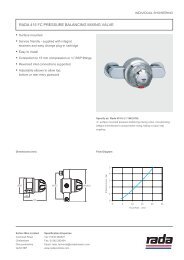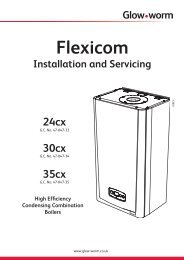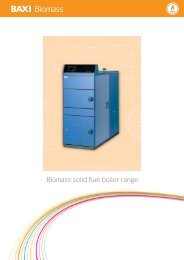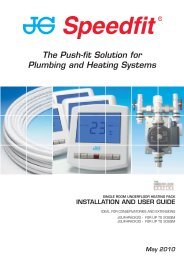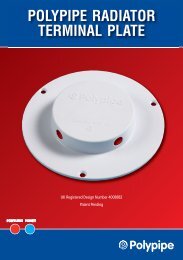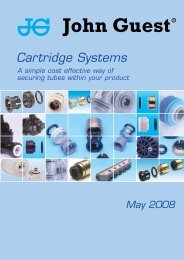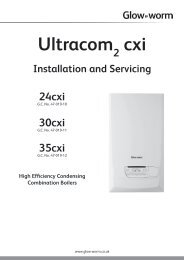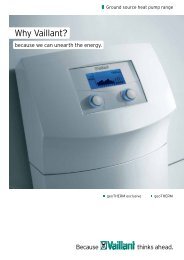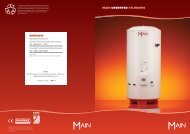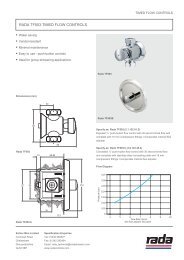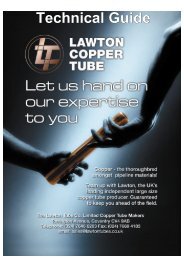Hep20 Technical Handbook
Hep20 Technical Handbook
Hep20 Technical Handbook
Create successful ePaper yourself
Turn your PDF publications into a flip-book with our unique Google optimized e-Paper software.
Connection to<br />
Compression Fittings<br />
Hep 2 O ® pipe is suitable for<br />
connecting to compression fittings<br />
complying with BS EN 1254.<br />
Cut the Hep 2 O ® pipe with the<br />
recommended cutters and proceed<br />
as shown below.<br />
Insert support sleeve into pipe<br />
Apply PTFE if required<br />
Ensure pipe is fully inserted<br />
Tightening nut<br />
1<br />
2<br />
3<br />
4<br />
Connections Adjacent to<br />
Capillary Joints<br />
When using Hep 2 O ® pipe or<br />
fittings adjacent to capillary joints it<br />
is preferable to carry out the<br />
soldering work before the Hep 2 O ®<br />
is installed.<br />
If it is not possible to undertake the<br />
work in this sequence then the<br />
following precautions should be<br />
observed:<br />
•<br />
do keep flame or soldering irons<br />
away from Hep 2 O ® .<br />
•<br />
do not allow flux to run onto<br />
Hep 2 O ® . Flux runs inside pipe<br />
may occur during soldering. This<br />
effect can be reduced by not<br />
using excessive amounts of flux<br />
and by applying flux to copper<br />
tube end only.<br />
•<br />
do not allow hot solder to come<br />
into contact with Hep 2 O ® .<br />
•<br />
to prevent overheating of<br />
Hep 2 O ® by conduction of heat<br />
along copper pipe, where<br />
necessary, wrap a damp cloth<br />
around copper pipe to minimise<br />
this effect.<br />
•<br />
systems should be flushed with<br />
water to remove any internal flux<br />
residues.<br />
Connection to Chrome<br />
Plated Copper or<br />
Stainless Steel Pipe<br />
Hep 2 O ® fittings cannot be<br />
connected directly to chrome plated<br />
copper or stainless steel, because of<br />
the relative surface hardness of<br />
these materials. Therefore<br />
compression fittings should be used.<br />
Connection to Brass<br />
Spigots<br />
The only brass spigots which are<br />
suitable for jointing into Hep 2 O ®<br />
fittings are those within the Hep 2 O ®<br />
range. Brass spigots designed for<br />
compression or capillary joints do<br />
not have the necessary joint grooves<br />
and are too short.<br />
Connection to Acorn ®<br />
Hep 2 O ® is fully compatible with its<br />
predecessor, Acorn ® system<br />
previously manufactured by Bartol,<br />
a Hepworth company.<br />
Pre-1984 Acorn ® 22mm pipe was<br />
manufactured with a thicker wall and<br />
requires a different support sleeve. If<br />
carrying out remedial work on such<br />
an Acorn ® system please contact<br />
our <strong>Technical</strong> Advisory Service.<br />
Internal components of current<br />
Hep 2 O ® fittings (Cap, BiTite Grab<br />
Wedge,Wedge Support Ring and ‘O’<br />
Ring) are not in any way compatible<br />
with original Hep 2 O ® fitting<br />
components (Cap,‘O’ Ring, Spacer<br />
Washer and Grab Ring) and<br />
therefore bodies and components<br />
must not be mixed.<br />
However, Hep 2 O ® Pipe (Standard<br />
or Barrier) is fully compatible with<br />
all versions of Hep 2 O ® fittings.<br />
For further advice and information<br />
contact Hepworth Plumbing<br />
Products’ <strong>Technical</strong> Advisory Service.<br />
Connection to Plastic<br />
Pipes<br />
Hep 2 O ® should not be used in<br />
conjunction with other<br />
manufacturers’ plastics pipe and<br />
fittings as dimensional tolerances and<br />
quality control cannot be guaranteed<br />
by Hepworth Plumbing Products.<br />
47



